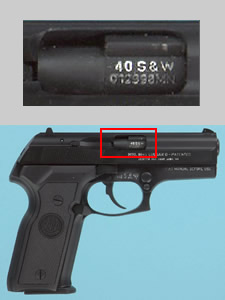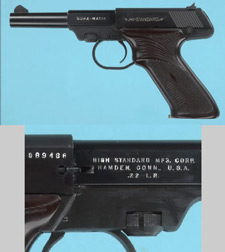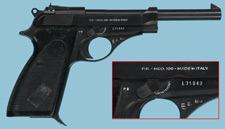Home | Glossary | Resources | Help | Contact Us | Course Map
Archival Notice
This is an archive page that is no longer being updated. It may contain outdated information and links may no longer function as originally intended.
Firearms Identification Information
Modern commercial firearms produced in or imported to the United States are required to have their basic identification information readily available on the firearm. Prior to 1968, serial numbers were not required on long guns.
Firearm identification information includes the following:
- Brand name or trademark
- Serial number
- Model designation
- Caliber designation
- Importer, if applicable
Confusion may occur when the caliber designation contains the name of a firearm manufacturer such as 38 Smith & Wesson or 223 Remington. For example, a first responder (or anyone not familiar with firearms identification) may mistakenly identify a firearm manufactured by Rohm as a Smith & Wesson because the barrel of the gun bears the mark 38 S&W, which is actually the designation for the recommended type of ammunition. The firearm examiner must be aware of the potential for confusion and verify the information contained in the submission documents.
A number of firearms may be manufactured by one company and bear the name of the company that sold the firearm in their retail outlets, such as Western Auto, Sears, and Belknap. Many of these types of firearms do not have serial numbers, but do contain part numbers or store identification numbers. These are not serial numbers and should not be used as such. The examiner should not only list the brand name found on the firearm but should also determine the actual manufacturer of the firearm. Numerous lists and charts are available that contain this information.
View a list of firearms identification information at www.e-gunparts.com.
Read more about Small Arms Ammunition in Module 5.
Military Firearms
Military firearms can be difficult to identify because they typically do not have a caliber designation; symbols and codes are used to identify the manufacturer. Measuring the bore diameter and chamber will normally provide the information needed to make a caliber determination. Knowledge of commonly used military ammunition assists the examiner in determining the caliber designation of a military weapon.
Proof Marks
Some older foreign manufactured firearms, such as pistols from Spain and Italy, will list a location, rather than a manufacturer . These firearms are cottage industry type weapons without a specific brand name. The examiner must rely on proof marks when trying to identify these firearms. There are a number of reference books that display proof marks and their meanings.
Additional Online Courses
- What Every First Responding Officer Should Know About DNA Evidence
- Collecting DNA Evidence at Property Crime Scenes
- DNA – A Prosecutor’s Practice Notebook
- Crime Scene and DNA Basics
- Laboratory Safety Programs
- DNA Amplification
- Population Genetics and Statistics
- Non-STR DNA Markers: SNPs, Y-STRs, LCN and mtDNA
- Firearms Examiner Training
- Forensic DNA Education for Law Enforcement Decisionmakers
- What Every Investigator and Evidence Technician Should Know About DNA Evidence
- Principles of Forensic DNA for Officers of the Court
- Law 101: Legal Guide for the Forensic Expert
- Laboratory Orientation and Testing of Body Fluids and Tissues
- DNA Extraction and Quantitation
- STR Data Analysis and Interpretation
- Communication Skills, Report Writing, and Courtroom Testimony
- Español for Law Enforcement
- Amplified DNA Product Separation for Forensic Analysts





